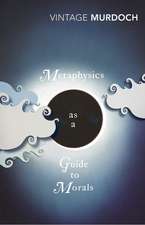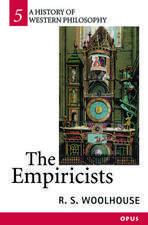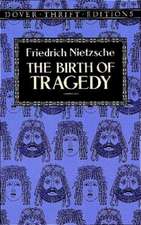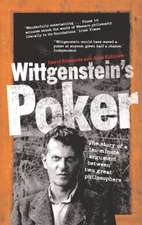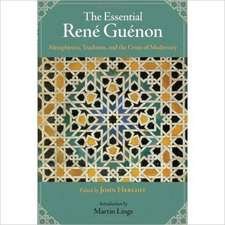The Metaphysics of Henry More: International Archives of the History of Ideas Archives internationales d'histoire des idées, cartea 207
Autor Jasper Reiden Limba Engleză Paperback – 11 iun 2014
| Toate formatele și edițiile | Preț | Express |
|---|---|---|
| Paperback (1) | 1386.17 lei 43-57 zile | |
| SPRINGER NETHERLANDS – 11 iun 2014 | 1386.17 lei 43-57 zile | |
| Hardback (1) | 1390.89 lei 43-57 zile | |
| SPRINGER NETHERLANDS – 23 mai 2012 | 1390.89 lei 43-57 zile |
Din seria International Archives of the History of Ideas Archives internationales d'histoire des idées
- 24%
 Preț: 679.97 lei
Preț: 679.97 lei - 18%
 Preț: 728.43 lei
Preț: 728.43 lei -
 Preț: 380.25 lei
Preț: 380.25 lei -
 Preț: 382.18 lei
Preț: 382.18 lei -
 Preț: 382.36 lei
Preț: 382.36 lei -
 Preț: 385.84 lei
Preț: 385.84 lei -
 Preț: 381.43 lei
Preț: 381.43 lei -
 Preț: 380.45 lei
Preț: 380.45 lei - 18%
 Preț: 1218.35 lei
Preț: 1218.35 lei -
 Preț: 379.68 lei
Preț: 379.68 lei -
 Preț: 399.29 lei
Preț: 399.29 lei - 18%
 Preț: 950.03 lei
Preț: 950.03 lei -
 Preț: 385.08 lei
Preț: 385.08 lei - 18%
 Preț: 953.20 lei
Preț: 953.20 lei - 15%
 Preț: 648.24 lei
Preț: 648.24 lei - 15%
 Preț: 641.03 lei
Preț: 641.03 lei - 18%
 Preț: 954.93 lei
Preț: 954.93 lei - 18%
 Preț: 944.19 lei
Preț: 944.19 lei - 15%
 Preț: 643.00 lei
Preț: 643.00 lei - 18%
 Preț: 1825.40 lei
Preț: 1825.40 lei - 18%
 Preț: 1224.54 lei
Preț: 1224.54 lei - 15%
 Preț: 644.63 lei
Preț: 644.63 lei - 15%
 Preț: 633.53 lei
Preț: 633.53 lei - 15%
 Preț: 647.08 lei
Preț: 647.08 lei - 18%
 Preț: 1233.06 lei
Preț: 1233.06 lei -
 Preț: 390.25 lei
Preț: 390.25 lei - 18%
 Preț: 945.92 lei
Preț: 945.92 lei - 18%
 Preț: 951.91 lei
Preț: 951.91 lei - 18%
 Preț: 1219.63 lei
Preț: 1219.63 lei - 15%
 Preț: 638.24 lei
Preț: 638.24 lei - 18%
 Preț: 1223.43 lei
Preț: 1223.43 lei
Preț: 1386.17 lei
Preț vechi: 1690.45 lei
-18% Nou
Puncte Express: 2079
Preț estimativ în valută:
265.33€ • 288.30$ • 223.02£
265.33€ • 288.30$ • 223.02£
Carte tipărită la comandă
Livrare economică 21 aprilie-05 mai
Preluare comenzi: 021 569.72.76
Specificații
ISBN-13: 9789400795464
ISBN-10: 9400795467
Pagini: 420
Ilustrații: VIII, 412 p.
Dimensiuni: 155 x 235 x 22 mm
Greutate: 0.59 kg
Ediția:2012
Editura: SPRINGER NETHERLANDS
Colecția Springer
Seria International Archives of the History of Ideas Archives internationales d'histoire des idées
Locul publicării:Dordrecht, Netherlands
ISBN-10: 9400795467
Pagini: 420
Ilustrații: VIII, 412 p.
Dimensiuni: 155 x 235 x 22 mm
Greutate: 0.59 kg
Ediția:2012
Editura: SPRINGER NETHERLANDS
Colecția Springer
Seria International Archives of the History of Ideas Archives internationales d'histoire des idées
Locul publicării:Dordrecht, Netherlands
Public țintă
ResearchCuprins
1. Introduction.- 1.1. The Place of Henry More in Seventeenth-Century Thought.- 1.2. More’s Goals, Targets and Influences.- 1.3. Epistemology and Rhetoric.- 2. Atoms and Void.- 2.1. Background.- 2.2. Henry More on Atoms.- 2.3. The Void.- 2.4. The Extension of the Universe, and Extramundane Void.- 2.5. Impenetrability.- 2.6. Atomic Shape. 3. Hyle, Atoms and Space.- 3.1. Background.- 3.2. Hyle, Atoms and Space in More’s Philosophical Poems.- 3.3. More’s Equivocation on the Nature of Hyle, 1653–1662.- 3.4. More’s Mature Conception of Hyle.- 4. Real Space.- 4.1. Background.- 4.2. The Immobility of the Parts of Space I: More’s Cylinder.- 4.3. The Immobility of the Parts of Space II: The Reciprocity of Motion.- 4.4. What Space Could Not Be.- 4.5. The Reception of More’s Theories of Space.- 5. Spiritual Presence.- 5.1. Background: Holenmerianism and Nullibism.- 5.2. More’s Refutation of Nullibism.- 5.3. More and Holenmerianism.- 5.4. Time and Eternity.- 6. Spiritual Extension.- 6.1. Introduction.- 6.2. Indiscerpibility.- 6.3. Penetrability.- 6.4. Self-penetration, Essential Spissitude, and Hylopathia.- 6.5. Divine Real Space.- 6.6. Divine Space before and after Henry More.- 7. Living Matter.- 7.1. Life and Soul.- 7.2. Gradual Monism in More’s Philosophical Poems.- 7.3. Life and Causation in the More-Descartes Correspondence.- 7.4. More’s Subsequent Reversal: the Case of Francis Glisson.- 7.5. Anne Conway and Francis Mercury van Helmont.- 7.6. The Eagle-Boy-Bee.- 7.7. More–Conway–van Helmont–Leibniz.- 8. Mechanism and its Limits.- 8.1. Introduction.- 8.2. Mechanism in More’s Early Works.- 8.3. The Limits of Mechanism: Some Case Studies.- 8.4. ‘Mixed Mechanics’.- 8.5. The Fate of the Mechanical Philosophy: Boyle, Newton and beyond.- 9. The Spirit of Nature.- 9.1. Background.- 9.2. Psyche, Physis, the Mundane Spright, and the Spirit of the World.- 9.3. The Spirit of Nature, and Particular Spirits.- 9.4. Occasionalism and Bungles.- 9.5. The Fate of the Spirit of Nature.- 10. The Life of the Soul.- 10.1. The Pre-Existence of the Soul.- 10.2. The Immortality of the Soul, and Aerial and Aethereal Vehicles.- 10.3. The Animal and Divine Lives.- 10.4. The Fall and Rise of the Soul.- Editions Cited.
Recenzii
“Reid’s book is the first comprehensive study of Henry More as a metaphysician, attentive to the broad picture as well as to fine details. As such, it is to be saluted as a great achievement in the field of the history of early modern philosophy … . Reid has also performed a great service to readers, for his book is written in a clear and compelling style … .” (Guido Giglioni, Journal of the History of Philosophy, Vol. 54 (3), July, 2016)
Notă biografică
Jasper Reid studied philosophy at Cambridge and Princeton, and is now a lecturer in philosophy at King's College London. His main area of research is in the history of philosophy of the early modern period, particularly on the metaphysical and epistemological side. He has written on a number of figures from that period, including Henry More, Descartes, Malebranche, Berkeley and Jonathan Edwards; and on a number of themes, including space, immaterialism, and early modern philosophy of mathematics.
Textul de pe ultima copertă
From his correspondence with Descartes in the 1640s to his discussions with Isaac Newton in the 1680s, Henry More (1614–1687) was a central figure in seventeenth-century philosophy. Notwithstanding his occasional portrayal as a rather eccentric anachronism, excessively wedded to the Neoplatonism of the past, the fact is that he was involved in some of the most cutting-edge debates of the day, and engaged with most of the giants of that great age of geniuses. The present work takes More seriously as a subtle and systematic early-modern metaphysician. It explores his ideas in relation to those of his contemporaries, both friends and foes, while also taking care not to neglect his Neoplatonic heritage; but it also reveals just how original a thinker he was in his own right. Topics include More’s evolving conception of Hyle (or first matter); his account of the physical world, a world of atoms without void; his theory of immaterial extension, and the divine real space that underlay thisworld; his attitude to mechanical explanations in physics, and his preferred theory of the Spirit of Nature; his developing attitude to the notion of living matter; and his views on the life of the human soul, before as well as after its union with the human body.
Caracteristici
A fully systematic and sustained examination of More's own highly systematic metaphysics, which one could not get from a multitude of discrete, self-contained articles Several new insights into More's philosophy that have thus far been missed altogether in the existing secondary literature Considerable light is also shed on the ideas of other , better-known figures, such as Descartes or Newton

